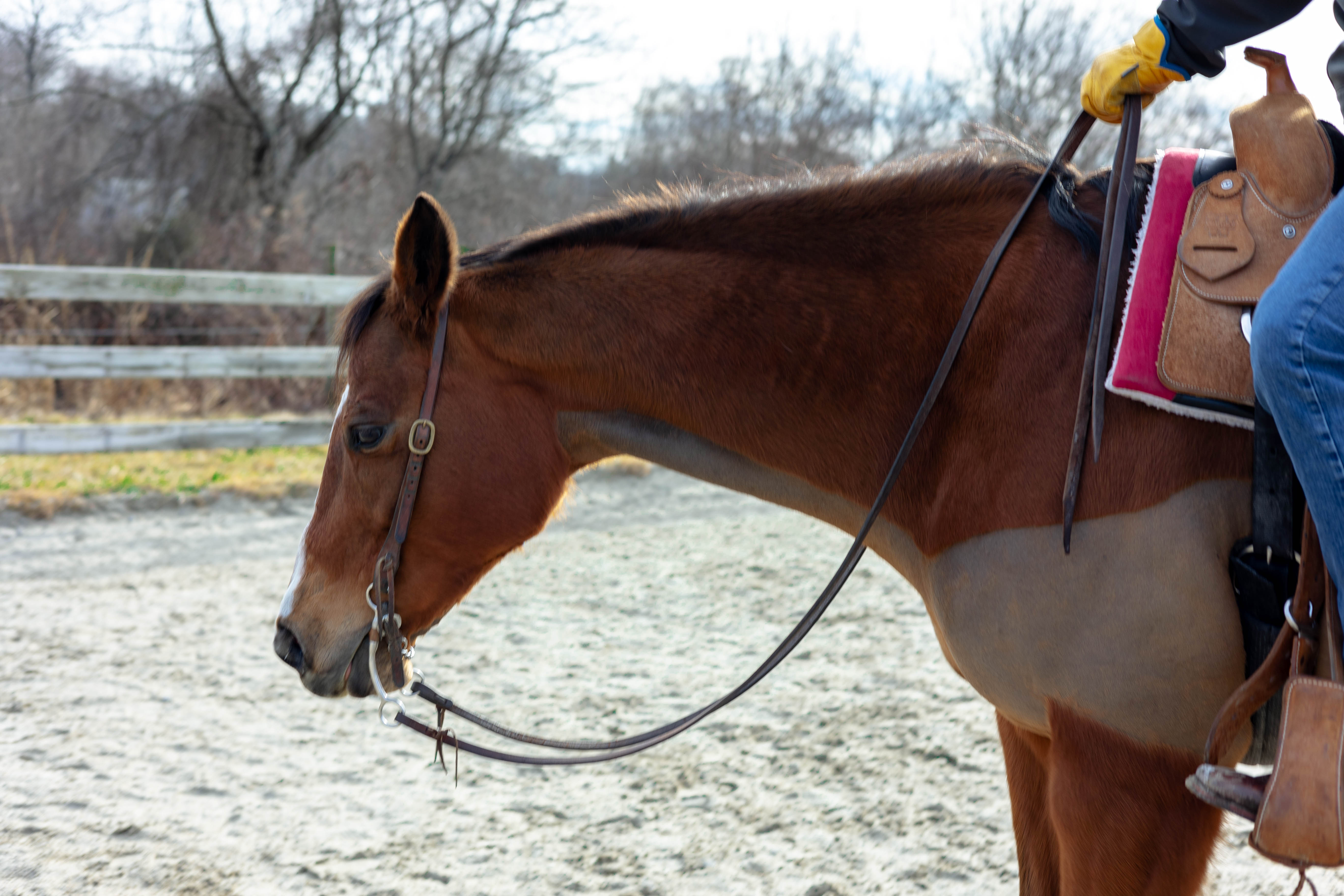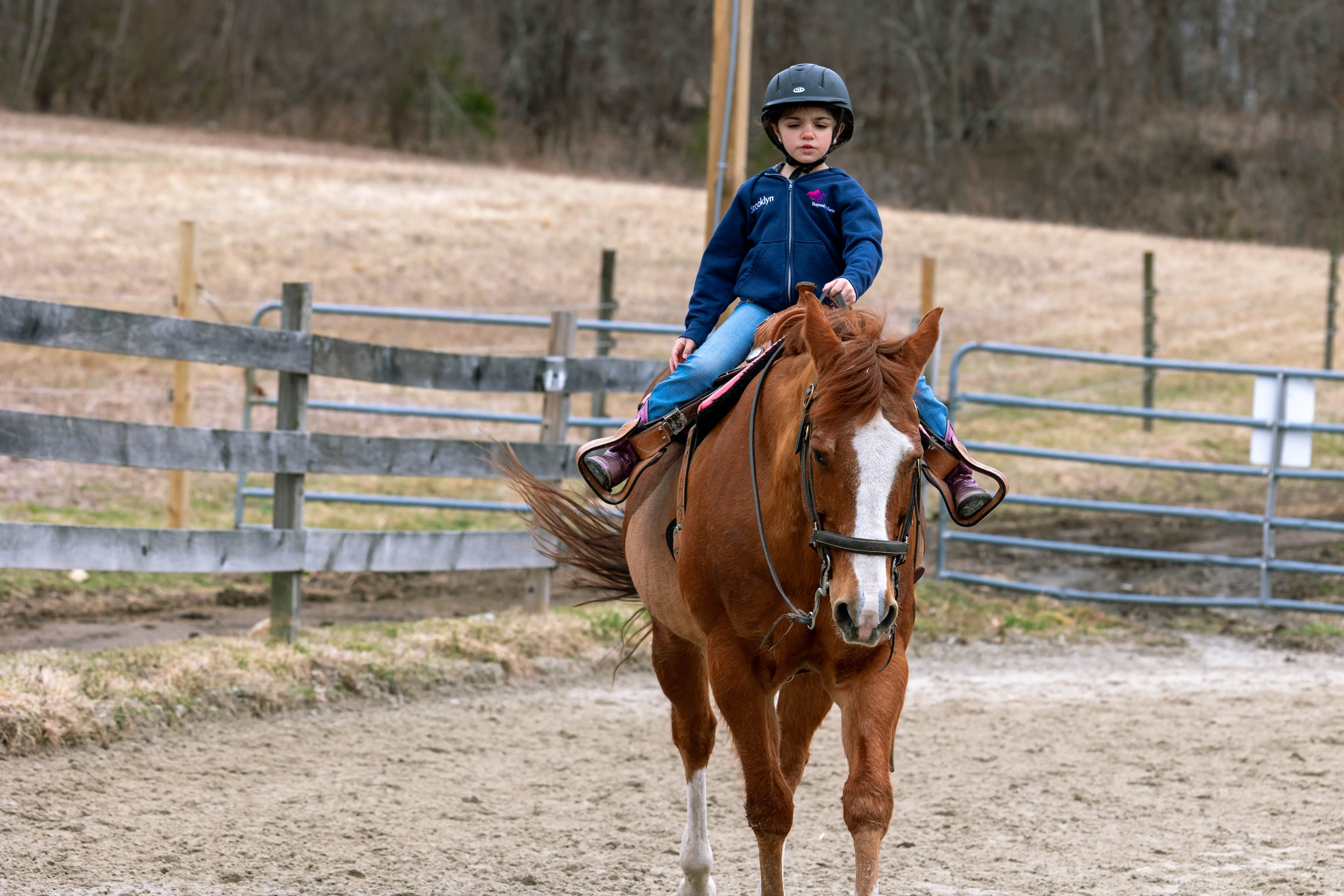As a beginner rider, learning to ride with one hand can be difficult and intimidating for a number of reasons. For starters, it’s not intuitive and you have to learn to control the urge to force the horse to do what you want as it is not effective. Learning to ride with one hand and to neck rein takes body control, coordination, precision and mindfulness.
In this article we’ll break down ways to steer with one hand more effectively and take the frustration out of learning to neck rein.
1. Keep The Reins In Front Of The Horn
When you’re first learning how to neck rein one of the most important keys to remember is keeping your rein hand out in front of your saddle. In order to cue the horse properly the reins need to be able to touch the horse’s neck and not the shoulder.
This may seem obvious but often times novice riders try to steer by laying the rein against the horse’s shoulder and ride with their rein hand too close to their body.
Neck reining isn’t about the amount of pressure you apply with the rein, it is intended to guide the horse with a soft cue. Often times riders become frustrated and add more force but as we will discuss later in this article, that is simply ineffective.
2. Maintain Forward Motion In Turns
Another common issue novice riders run into when learning to neck rein is the horse trying to stop. My 6 year old daughter is currently learning how to neck rein and often times loses her rhythm and pace when she starts steering.
This happens because riders get anxious that the horse isn’t going to turn and start to pull the reins. So, in addition to using your reins to guide the horse (instead of pulling) try to use your legs and seat to keep the horse going forward as well.
It’s like trying to drive a car and cutting the wheel all the way to make a turn while simultaneously slamming on the breaks. Ever tried turning your wheel while you’re not moving? It’s a bit difficult. So, remember to keep moving forward.
3. Use Your Feet & Legs
Using your feet and legs is crucial when you ride with one hand. No horse can balance or carry themselves if the rider is constantly pulling and not using any leg and this typically causes the horse to stop or resist as mentioned above.
Your seat, feet and legs are necessary for keeping the horse going and also for helping to steer the horse. Your feet can help the horse move his shoulders, rib cage or hips laterally as well as keeping the horse pushing from behind to maintain impulsion.
When I ride my horse in one hand I like to use my feet and legs as support when I’m steering. Some people prefer to steer the horse with their feet and that’s ok too.
For example, if I’m jogging my horse and want to turn left, I like to use my rein hand to guide the horse slightly to the left without pulling. Then tap my right (outside) foot in the rhythm of the jog near the girth, to help him around the turn. I don’t squeeze my outside leg to turn because I don’t want my horse to accidentally lope off. I just want to help him move his shoulders around the turn. And if I use my foot in rhythm my horse is more likely to maintain the correct pace around the turn.
Every horse is trained differently and not every discipline uses the same buttons. So, confirm with your instructor what the best way to cue your horse or the horse you’re riding is.
4. Look Where You Want To Go
Ahh, the age old saying. Look where you want the horse to go, not where the horse is taking you. I like to tell my daughter to look out into the dirt in front of her and look for the path where she wants the horse’s feet to go.
Yes, you should look up while riding but sometimes you have to look for the path first. Thinking about where you want to place your horse’s feet is crucial in all riding disciplines.
If you’ve been riding for a little while you’ve probably been in a situation where you wanted to steer around a cone in the arena. But you weren’t sure you would make it so you just kept staring at the cone in hopes that you wouldn’t run it over. Until, you ran it right over. Sound familiar?
Most riders start looking at an object they want to avoid and end up aiming right at it. Yet they have a hard time aiming at where they want to be. Try to remember how effectively staring down a cone made the horse go to the cone. Now use that to your advantage and find a different point of interest. Pick a spot and aim right for it, then as you approach it, pick a new spot.
Train yourself to use your eyes as another aid and another tool. Your body is more likely to follow your eyes and stay relaxed if you look where you are going.
For more steering tips, check out this article: 13 Beginner Steering Exercises
5. Shift Your Weight Slightly
Now as helpful as this next tip is, it’s easy to over exaggerate. And, we don’t want that. You don’t want to lean so far that you just slip right off your horse.
Shifting your weight in the saddle can and will help your horse turn. Shifting your weight by using your seat bones to sit a little more towards the side you want to turn and stepping into your inside stirrup can help prepare your horse for the turn.
Then, in combination with outside leg and a guiding neck rein your horse will make the turn more balanced.
The subtlety of this cue can be difficult to master, it takes a lot of practice. It’s important to stay sitting up tall and in the center of the saddle. You are simply dropping one hip and stepping into the stirrup when you shift your weight, instead of leaning to the direction you want to go.
Think about lowering one seat bone closer to the saddle by an inch and letting your other seat bone raise up slightly off the saddle. And shifting your weight so discretely that an onlooker wouldn’t notice that your position changed.
6. Don’t Pull The Reins Across The Horse’s Neck
If you have a Type A personality or like instant gratification, chances are this one is a real struggle for you. Learning not to use the reins to drag the horse around is difficult for everyone.
The problem with pulling the reins across the horse’s neck and forcing them to turn is, you end up turning the horse the wrong direction. Since neck reining uses indirect rein pressure to steer the horse, because you push on the neck instead of pulling the nose, you can easily over do it.
No matter what discipline you ride and even when riding with two hands, pulling the right rein to the left in order to go left is wrong. Why is it wrong? Well, when you pull the right rein to the left you turn the horse’s nose to the right. And the harder you pull the more you turn the horse’s head to the right. Then when you add leg to move the horse’s feet, he has no choice but to turn right.
Instead, you want to move your hand forward and up a little bit towards the direction you want to go. Try to point your pointer finger knuckle slightly towards the direction you want to go. If the horse doesn’t turn you may need to add more leg.
You can’t drive the car with only a steering wheel and no gas pedal, so if you find yourself getting stuck try using your leg to support the turn as discussed above.

7. Avoid Pulling Back When Steering
Similar to the last point above, many riders commonly pull back on the reins when trying to steer with one hand. The problem here is that you end up stopping the horse. And, without forward motion you cannot make the turn. You may aggravate your horse enough to spin around in small circles but he won’t walk, jog or lope around a turn.
Hand position is key when riding with one hand and neck reining the horse. So unless you are hoping to stop or slow down, refer to point number 1 and try to keep your rein hand in front of the saddle.
8. What To Do With Your Free Hand
And, last but not least, what on earth are you supposed to do with your free hand? There are a couple of options depending on what you’re working on. What you don’t want to do is let your free arm flop or wave around like you’re on a balance beam.
The first option is to keep your free hand in an equitation position as if you’re holding another rein. With your elbow close to your body, your hand closed and your thumb on top, you’ll may find it easier to stay sitting in the center of the saddle. You will also be able to sit tall and keep your free arm still.
The second option is to let your free hand hang straight down by your side which is commonly seen in western pleasure classes. If you choose to try this out, keep your fingers closed, you don’t want to lose your balance and accidentally jam your finger. This is a difficult way to ride if you’re not used to it because your arm is more prone to bouncing and swinging. You’ll want to try to keep your arm still and your shoulders back while riding in this position.
Lastly, you can ride with your free hand on your leg. This isn’t very common in the show ring anymore unless the rider is using Rommel reins. But, it may be comfortable for recreational or trail riding. All you need to do is curl your fingers so your hand is closed (are we seeing a theme here?) and place your knuckles on your leg in a resting position. Once again, keeping your hand and arm still.
I hope you’ve found this article helpful! If you did, please share it and pass it along to anyone else it may help!

